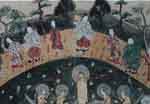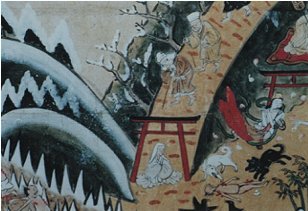 With this mandala the Bikuni (missionary nuns of
Kumano) taught about the various levels of consciousness
which people create for themselves. The mandala describes
ten main 'worlds', or states of being, which human beings
find themselves in. The mandala also teaches that from
any of these states of being the means of
Self-Realization is always close at hand. The only
requirement is to have a change of heart. These states
were considered to exist both here and now and in the
afterlife.
With this mandala the Bikuni (missionary nuns of
Kumano) taught about the various levels of consciousness
which people create for themselves. The mandala describes
ten main 'worlds', or states of being, which human beings
find themselves in. The mandala also teaches that from
any of these states of being the means of
Self-Realization is always close at hand. The only
requirement is to have a change of heart. These states
were considered to exist both here and now and in the
afterlife.
These Kumano Bikuni nuns
travelled all over Japan to spread the faith of Kumano
and also took a role similar to a tour conductor of
modern times. Jukkai means ten worlds which include the
six paths of Jigoku (hell), Gaki, Chikusho, Shura, Hito
(human world), Ten (heaven), and the four paths of
Shomon, Engaku, Bosatsu, and Hotoke (Buddha). Kanshin
means that all those ten worlds reside within our own
mind. This picture shows that the fragility and
instability of the human mind, as well as its salvation,
are dependent upon the state of our human consciousness.
to the top
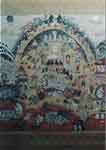 Life is
drawn here as a half circle. The stages from birth to old
age and death are symbolized in the trees accompanying
each stage. When we are born we are like the willow,
flexible and soft. In later life we progress through
stages symbolized by the cherry, pine, cedar, and red
maple trees, leading finally to death as symbolized by
the dead tree.
Life is
drawn here as a half circle. The stages from birth to old
age and death are symbolized in the trees accompanying
each stage. When we are born we are like the willow,
flexible and soft. In later life we progress through
stages symbolized by the cherry, pine, cedar, and red
maple trees, leading finally to death as symbolized by
the dead tree.
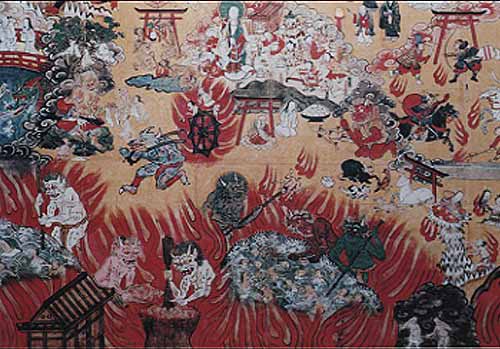 In the lower
part of this picture one of the Buddhist versions of hell
is depicted. This scene is the hell of suffering by fire.
Those residing in hell are those suffering from almost
complete ignorance and lack of will, do not know who they
are, where they are, where they are going, and do not
question why they are in a state of suffering.
In the lower
part of this picture one of the Buddhist versions of hell
is depicted. This scene is the hell of suffering by fire.
Those residing in hell are those suffering from almost
complete ignorance and lack of will, do not know who they
are, where they are, where they are going, and do not
question why they are in a state of suffering.
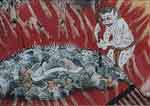 This part of the mandala shows that the more
one struggles with the pains of life the more one falls
into the hell of suffering; one becomes lost in a world
of suffering that can only be transcended by a kind of
surrender, or letting go of one's attachments. Hell does
not only exist after leaving the physical plane but is
also a projection of our own mind when consciousness of
our true self is lost and we fall into the abyss of
hatred and envy and so on. 'The sin we create becomes a
demon and the sword of the heart tortures ourselves' (Bikuni
Jigoku no Etoki' by Chikamatsu Monzaemon)
This part of the mandala shows that the more
one struggles with the pains of life the more one falls
into the hell of suffering; one becomes lost in a world
of suffering that can only be transcended by a kind of
surrender, or letting go of one's attachments. Hell does
not only exist after leaving the physical plane but is
also a projection of our own mind when consciousness of
our true self is lost and we fall into the abyss of
hatred and envy and so on. 'The sin we create becomes a
demon and the sword of the heart tortures ourselves' (Bikuni
Jigoku no Etoki' by Chikamatsu Monzaemon)
 In the center of this picture a man is
suffering as a result of his infidelity. In the lower
left hand corner a man is seen trying in vain to climb a
mountain of needles because he is attracted to the woman
smiling at him. If you have a close look at the picture,
you can find some descriptions which admonish against
doing bad deeds in this world. The pictures in the middle
and the left below both show evil intentions suffered by
males. The man constricted by a two-headed snake is
receiving punishment for being adulterous. The man on the
mountain of swords is lost in the spell of a flirtatious
smile of a woman. The mountain of swords is called 'the
forest of swords' where the man who climbs up is cut into
shreds, only to find that the woman is down below. And
when he climbs down he finds the woman is again on top of
the mountain again depicting a never-ending torture.
There must have been quite a few men who felt a
embarrassed when they heard the Bikuni nun's
interpretation of this mandala.
In the center of this picture a man is
suffering as a result of his infidelity. In the lower
left hand corner a man is seen trying in vain to climb a
mountain of needles because he is attracted to the woman
smiling at him. If you have a close look at the picture,
you can find some descriptions which admonish against
doing bad deeds in this world. The pictures in the middle
and the left below both show evil intentions suffered by
males. The man constricted by a two-headed snake is
receiving punishment for being adulterous. The man on the
mountain of swords is lost in the spell of a flirtatious
smile of a woman. The mountain of swords is called 'the
forest of swords' where the man who climbs up is cut into
shreds, only to find that the woman is down below. And
when he climbs down he finds the woman is again on top of
the mountain again depicting a never-ending torture.
There must have been quite a few men who felt a
embarrassed when they heard the Bikuni nun's
interpretation of this mandala.
to the top
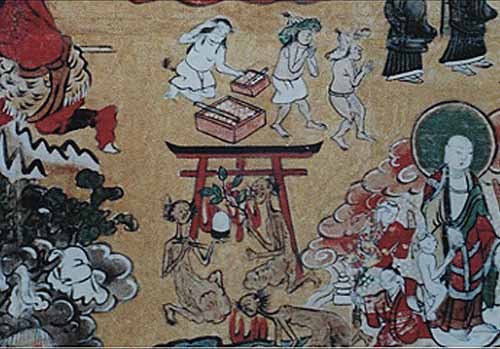 In Buddhism
it is believed that only human beings whose consciousness
remains on the lower six worlds of the ten worlds of
human existence must reincarnate. The lowest of these six
worlds is considered hell. The next level is called
Gaki-do and is the world depicted here in this part of
the mandala. This level of consciousness can be said to
be one of constant desire and a sense of lack even when
one has more than enough. In modern times it can be seen
in the constant desire for more things and more
stimulation. People consume out of a sense of lack, not
out of true need. We are reminded of the compulsive
consumer who needs to constantly shop and consume in
order to feel alive. These people can never be satisfied
for in their mind is the constant sense of lack, of
emptiness.
In Buddhism
it is believed that only human beings whose consciousness
remains on the lower six worlds of the ten worlds of
human existence must reincarnate. The lowest of these six
worlds is considered hell. The next level is called
Gaki-do and is the world depicted here in this part of
the mandala. This level of consciousness can be said to
be one of constant desire and a sense of lack even when
one has more than enough. In modern times it can be seen
in the constant desire for more things and more
stimulation. People consume out of a sense of lack, not
out of true need. We are reminded of the compulsive
consumer who needs to constantly shop and consume in
order to feel alive. These people can never be satisfied
for in their mind is the constant sense of lack, of
emptiness. to the top
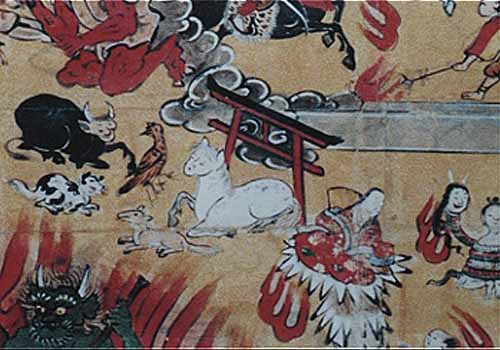 The next
higher level after Gaki-do is Chikusho-do (lower right).
Here a person is simply a slave of the appetites for
food, drink, sex, and so on. The animal instincts and
desires govern all one's thoughts and actions. The next
higher level is Shura-do (center). Here people live in
constant fear of being killed or harmed in some way. The
world is hostile in their minds and their life is one of
struggle, war, and death. They are always in the mindset
of attacking before being attacked.
The next
higher level after Gaki-do is Chikusho-do (lower right).
Here a person is simply a slave of the appetites for
food, drink, sex, and so on. The animal instincts and
desires govern all one's thoughts and actions. The next
higher level is Shura-do (center). Here people live in
constant fear of being killed or harmed in some way. The
world is hostile in their minds and their life is one of
struggle, war, and death. They are always in the mindset
of attacking before being attacked. to the top
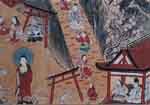
to the top
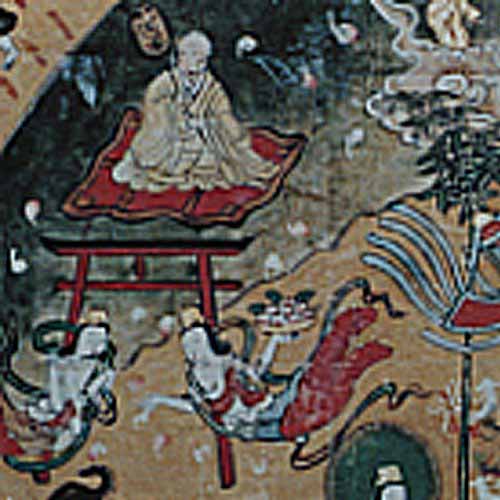 Tenjo-do is
the next level above Ningen-do. This is the highest level
into which we are said to reincarnate. At this level of
being we are living a life of ease fully satisfied in a
life of wealth, power, and comfort. This is a most
precarious stage for it is where we are tested. Here the
old expression 'the higher you rise the farther you fall'
sums up the dangers inherent in this level of being. Here
our tendencies toward all the vices of the lower levels
of being are tried and tested. Attachment to our wealth,
greed, snobbishness, pride, and the selfish wielding of
one's power all lead us rapidly back into the lower
states of being, either in this life or the next.
Tenjo-do is
the next level above Ningen-do. This is the highest level
into which we are said to reincarnate. At this level of
being we are living a life of ease fully satisfied in a
life of wealth, power, and comfort. This is a most
precarious stage for it is where we are tested. Here the
old expression 'the higher you rise the farther you fall'
sums up the dangers inherent in this level of being. Here
our tendencies toward all the vices of the lower levels
of being are tried and tested. Attachment to our wealth,
greed, snobbishness, pride, and the selfish wielding of
one's power all lead us rapidly back into the lower
states of being, either in this life or the next. to the top

to the top
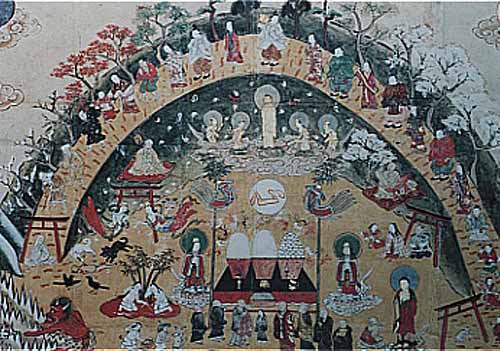 In the center of this Mandala is the Chinese
character for 'heart' or 'mind'. Engaku is therefore the
stage where one is now able to reach into the heart of
Eternal Being. 'En' means enlightenment and 'gaku' means
to feel. It is the stage of Self-Realization or
Enlightenment. The next stage after this is to enter into
Buddhic consciousness where one experiences the true
meaning of cause and effect. By showing these various
stages of human existence as depicted in the Kumano
Jukkai Mandala, the Kumano Bikuni attempted to instill in
the minds of all the people they met the fact of the
essential divinity of all beings. They taught that
everyone had the potential for realizing enlightenment in
this life regardless of their present station or life
situation. By a simple shift in perspective one could
attain the highest levels of existence. And conversely,
by a simple shift in perspective one could also descend
into the miseries of hell in this life and in the next.
By rising above the realms of lower desire, worldly
illusion and glamour, and by coming to focus one's
conscious awareness on 'That Which Is, always Has Been,
and always Will Be', the Kumano Bikuni taught that one
could find true peace in spiritual awakening. They also
taught that Kumano was a special place which had the
power to serve as a catalyst for such an awakening.
In the center of this Mandala is the Chinese
character for 'heart' or 'mind'. Engaku is therefore the
stage where one is now able to reach into the heart of
Eternal Being. 'En' means enlightenment and 'gaku' means
to feel. It is the stage of Self-Realization or
Enlightenment. The next stage after this is to enter into
Buddhic consciousness where one experiences the true
meaning of cause and effect. By showing these various
stages of human existence as depicted in the Kumano
Jukkai Mandala, the Kumano Bikuni attempted to instill in
the minds of all the people they met the fact of the
essential divinity of all beings. They taught that
everyone had the potential for realizing enlightenment in
this life regardless of their present station or life
situation. By a simple shift in perspective one could
attain the highest levels of existence. And conversely,
by a simple shift in perspective one could also descend
into the miseries of hell in this life and in the next.
By rising above the realms of lower desire, worldly
illusion and glamour, and by coming to focus one's
conscious awareness on 'That Which Is, always Has Been,
and always Will Be', the Kumano Bikuni taught that one
could find true peace in spiritual awakening. They also
taught that Kumano was a special place which had the
power to serve as a catalyst for such an awakening. to the top

